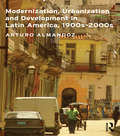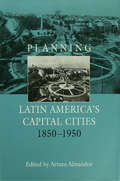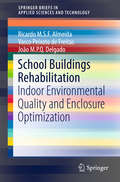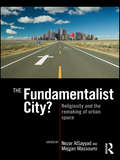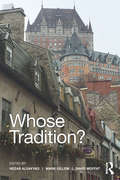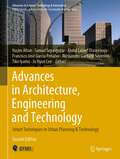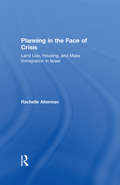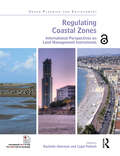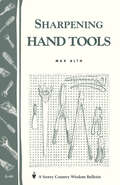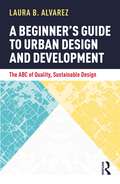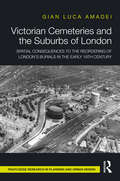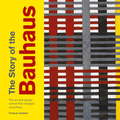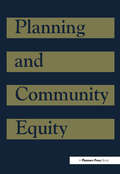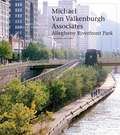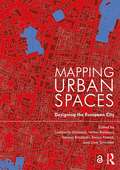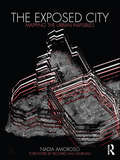- Table View
- List View
Modernization, Urbanization and Development in Latin America, 1900s - 2000s (Planning, History and Environment Series)
by Arturo AlmandozIn this book Arturo Almandoz places the major episodes of Latin America’s twentieth and early twenty-first century urban history within the changing relationship between industrialization and urbanization, modernization and development. This relationship began in the early twentieth century, when industrialization and urbanization became significant in the region, and ends at the beginning of the twenty-first century, when new tensions between liberal globalization and populist nationalism challenge development in the subcontinent, much of which is still poverty stricken. Latin America’s twentieth-century modernization and development are closely related to nineteenth-century ideals of progress and civilization, and for this reason Almandoz opens with a brief review of that legacy for the different countries that are the focus of his book – Mexico, Chile, Brazil, Argentina and Venezuela – but with references to others. He then explores the regional distortions, which resulted from the interaction between industrialization and urbanization, and how the imbalance between urbanization and the productive system helps to explain why ‘take-off’ was not followed by the ‘drive to maturity’ in Latin American countries. He suggests that the close yet troublesome relationship with the United States, the recurrence of dictatorships and autocratic regimes, and Marxist influences in many domains, are all factors that explain Latin America’s stagnation and underdevelopment up to the so-called ‘lost decade’ of 1980s. He shows how Latin America’s fate changed in the late twentieth and early twenty-first century, when neoliberal programmes, political compromise and constitutional reform dismantled the traditional model of the corporate state and centralized planning. He reveals how economic growth and social improvements have been attained by politically left-wing yet economically open-market countries while others have resumed populism and state intervention. All these trends make up the complex scenario for the new century – especially when considered against the background of vibrant metropolises that are the main actors in the book.
Planning Latin America's Capital Cities 1850-1950 (Planning, History And The Environment Ser.)
by Arturo AlmandozIn this first comprehensive work in English to describe the building of Latin America's capital cities in the postcolonial period, Arturo Almandoz and his contributors demonstrate how Europe and France in particular shaped their culture, architecture and planning until the United States began to play a part in the 1930s. The book provides a new per
Planning Latin America's Capital Cities 1850-1950
by Arturo AlmandozIn this first comprehensive work in English to describe the building of Latin America's capital cities in the postcolonial period, Arturo Almandoz and his contributors demonstrate how Europe and France in particular shaped their culture, architecture and planning until the United States began to play a part in the 1930s. The book provides a new per
School Buildings Rehabilitation: Indoor Environmental Quality and Enclosure Optimization (SpringerBriefs in Applied Sciences and Technology)
by Ricardo M.S.F. Almeida Vasco Peixoto de Freitas João M.P.Q. DelgadoThis book discusses the effect of different school building rehabilitation strategies on the classrooms’ indoor environmental quality (IEQ) and presents a multi-objective methodology for school building enclosure optimization combining artificial neural networks and lifecycle costs. The special features of this book are that it (a) presents the state-of-the-art in school building rehabilitation, (b) covers the IEQ assessment of several school buildings, including non-rehabilitated and rehabilitated according to different strategies; and (c) proposes a multi-objective optimization procedure.The rehabilitation of a school building should be regarded as a procedure combining a number of (sometimes conflicting) variables and objectives, including energy, IEQ and costs (initial, operational and maintenance), in the search for an “optimum solution.” The main benefit of the book is that it discusses the main topics related to school building rehabilitation, presents results of the IEQ assessment on 9 school buildings and launches a discussion on how the “in-use” performance of schools is key to understanding how designed performance is actually experienced. It maps the most commonly used multi-objective algorithms and artificial neural network architectures and proposes a methodology for combining these numerical tools with dynamic building simulations and lifecycle cost analysis to optimize school building enclosures. This methodology will be of value to scientists and engineers alike, while also addressing a variety of related disciplines, such as civil and mechanical engineering, architecture and mathematics.
The Fundamentalist City?: Religiosity and the Remaking of Urban Space
by Nezar AlSayyadThe relationship between urbanism and fundamentalism is a very complex one. This book explores how the dynamics of different forms of religious fundamentalisms are produced, represented, and practiced in the city. It attempts to establish a relationship between two important phenomena: the historic transition of the majority of the world’s population from a rural to an urban existence; and the robust resurgence of religion as a major force in the shaping of contemporary life in many parts of the world. Employing a transnational interrogation anchored in specific geographic regions, the contributors to this volume explore the intellectual and practical challenges posed by fundamentalist groups, movements, and organizations. They focus on how certain ultra religious practices of Christianity, Hinduism, Islam, and Judaism have contributed to the remaking of global urban space. Their work suggests that it is a grave oversimplification to view religious orthodoxies or doctrines as the main cause of urban terrorism or violence. Instead they argue that such phenomena should be understood as a particular manifestation of modernity’s struggles. Nezar AlSayyad and Mejgan Massoumi’s book provides fascinating reading for those interested in religion and the city, with thought provoking pieces from experts in anthropology, geography sociology, religious studies, and urban studies.
Whose Tradition?: Discourses on the Built Environment
by Nezar AlSayyad Mark Gillem David MoffatIn seeking to answer the question Whose Tradition? this book pursues four themes: Place: Whose Nation, Whose City?; People: Whose Indigeneity?; Colonialism: Whose Architecture?; and Time: Whose Identity?Following Nezar AlSayyad’s Prologue, contributors addressing the first theme take examples from Indonesia, Myanmar and Brazil to explore how traditions rooted in a particular place can be claimed by various groups whose purposes may be at odds with one another. With examples from Hong Kong, a Santal village in eastern India and the city of Kuala Lumpur, contributors investigate the concept of indigeneity, the second theme, and its changing meaning in an increasingly globalized milieu from colonial to post-colonial times. Contributors to the third theme examine the lingering effects of colonial rule in altering present-day narratives of architectural identity, taking examples from Guam, Brazil, and Portugal and its former colony, Mozambique. Addressing the final theme, contributors take examples from Africa and the United States to demonstrate how traditions construct identities, and in turn how identities inform the interpretation and manipulation of tradition within contexts of socio-cultural transformation in which such identities are in flux and even threatened. The book ends with two reflective pieces: the first drawing a comparison between a sense of ‘home’ and a sense of tradition; the second emphasizing how the very concept of a tradition is an attempt to pin down something that is inherently in flux.
The Fundamentalist City?: Religiosity and the Remaking of Urban Space
by Nezar AlSayyad Mejgan MassoumiThe relationship between urbanism and fundamentalism is a very complex one. This book explores how the dynamics of different forms of religious fundamentalisms are produced, represented, and practiced in the city. It attempts to establish a relationship between two important phenomena: the historic transition of the majority of the world’s population from a rural to an urban existence; and the robust resurgence of religion as a major force in the shaping of contemporary life in many parts of the world. Employing a transnational interrogation anchored in specific geographic regions, the contributors to this volume explore the intellectual and practical challenges posed by fundamentalist groups, movements, and organizations. They focus on how certain ultra religious practices of Christianity, Hinduism, Islam, and Judaism have contributed to the remaking of global urban space. Their work suggests that it is a grave oversimplification to view religious orthodoxies or doctrines as the main cause of urban terrorism or violence. Instead they argue that such phenomena should be understood as a particular manifestation of modernity’s struggles. Nezar AlSayyad and Mejgan Massoumi’s book provides fascinating reading for those interested in religion and the city, with thought provoking pieces from experts in anthropology, geography sociology, religious studies, and urban studies.
Advances in Architecture, Engineering and Technology: Smart Techniques in Urban Planning & Technology (Advances in Science, Technology & Innovation)
by Haşim Altan Samad Sepasgozar Abdullateef Olanrewaju Francisco José García Peñalvo Alessandro Gaetano Severino Tiko Iyamu Ju Hyun LeeThis book summarizes the latest studies regarding innovation in urban design and planning. It shares many tips and insights about sustainable solutions for the issues facing transport systems, innovative digital technologies, and ICT trends. The book touches upon the need to integrate the three fields of Architecture, Engineering, and Technology that have become indispensable. This is intended to respond to the increasing human needs and population growth in cities on one hand and to develop a holistic approach that helps overcome challenges to sustainability and environment management on the other hand. With the power of engineering in practice, problems of design and development once considered too complex to be dealt with other than empirically, intuitively, or by trial and error, are now becoming more solvable and applicable. This book offers strategies and solutions that enable designers to bring together knowledge in the fields of architecture, engineering, and technology to overcome challenges facing in modern times.
Planning in the Face of Crisis: Land Use, Housing, and Mass Immigration in Israel
by Rachelle AltermanCritics of urban and regional planning argue that it is best suited to manage incremental change. Can a planner's skills and expertise be effective in handling a major crisis and large-scale change? The mass immigration from the former Soviet Union to Israel in the 1990s offers the opportunity to study one of the largest-scale (non-disaster) crisis situations in a democratic, advanced-economy country. This book recounts the fascinating saga of how policymakers and planners at both the national and local levels responded to the formidable demand for housing and massive urban growth. Planners forged new housing and land-use policies, and applied a streamlined (but controversial) planning law. The outputs were impressive. The outcomes and impacts changed the landscape and human-scape of Israel, heightening dilemmas of land use and urban policy in this high-density country.
Planning in the Face of Crisis: Land Use, Housing, and Mass Immigration in Israel (Cities And Regions Ser.)
by Rachelle AltermanCritics of urban and regional planning argue that it is best suited to manage incremental change. Can a planner's skills and expertise be effective in handling a major crisis and large-scale change? The mass immigration from the former Soviet Union to Israel in the 1990s offers the opportunity to study one of the largest-scale (non-disaster) crisis situations in a democratic, advanced-economy country. This book recounts the fascinating saga of how policymakers and planners at both the national and local levels responded to the formidable demand for housing and massive urban growth. Planners forged new housing and land-use policies, and applied a streamlined (but controversial) planning law. The outputs were impressive. The outcomes and impacts changed the landscape and human-scape of Israel, heightening dilemmas of land use and urban policy in this high-density country.
Regulating Coastal Zones: International Perspectives on Land Management Instruments (Urban Planning and Environment)
by Rachelle Alterman Cygal PellachRegulating Coastal Zones addresses the knowledge gap concerning the legal and regulatory challenges of managing land in coastal zones across a broad range of political and socio-economic contexts. In recent years, coastal zone management has gained increasing attention from environmentalists, land use planners, and decision-makers across a broad spectrum of fields. Development pressures along coasts such as high-end tourism projects, luxury housing, ports, energy generation, military outposts, heavy industry, and large-scale enterprise compete with landscape preservation and threaten local history and culture. Leading experts present fifteen case studies among advanced-economy countries, selected to represent three groups of legal contexts: signatories to the 2008 Mediterranean ICZM Protocol, parties to the 2002 EU Recommendation on Integrated Coastal Zone Management, and the USA and Australia. This book is the first to address the legal-regulatory aspects of coastal land management from a systematic cross-national comparative perspective. By including both successful and less-effective strategies, it aims to inform professionals, graduate students, policy makers, and NGOs of the legal and socio-political challenges as well as the better practices from which others could learn.
Regulating Coastal Zones: International Perspectives on Land Management Instruments (Urban Planning and Environment)
by Rachelle Alterman Cygal PellachRegulating Coastal Zones addresses the knowledge gap concerning the legal and regulatory challenges of managing land in coastal zones across a broad range of political and socio-economic contexts. In recent years, coastal zone management has gained increasing attention from environmentalists, land use planners, and decision-makers across a broad spectrum of fields. Development pressures along coasts such as high-end tourism projects, luxury housing, ports, energy generation, military outposts, heavy industry, and large-scale enterprise compete with landscape preservation and threaten local history and culture. Leading experts present fifteen case studies among advanced-economy countries, selected to represent three groups of legal contexts: signatories to the 2008 Mediterranean ICZM Protocol, parties to the 2002 EU Recommendation on Integrated Coastal Zone Management, and the USA and Australia. This book is the first to address the legal-regulatory aspects of coastal land management from a systematic cross-national comparative perspective. By including both successful and less-effective strategies, it aims to inform professionals, graduate students, policy makers, and NGOs of the legal and socio-political challenges as well as the better practices from which others could learn.
Sharpening Hand Tools: Storey's Country Wisdom Bulletin A-66 (Storey Country Wisdom Bulletin)
by Max AlthSince 1973, Storey's Country Wisdom Bulletins have offered practical, hands-on instructions designed to help readers master dozens of country living skills quickly and easily. There are now more than 170 titles in this series, and their remarkable popularity reflects the common desire of country and city dwellers alike to cultivate personal independence in everyday life.
A Beginner's Guide to Urban Design and Development: The ABC of Quality, Sustainable Design
by Laura B. AlvarezThis book provides invaluable guidance to all those with an interest in placemaking and the built environment, from those with no experience to those who have worked for many years in industry, illustrating key principles that will secure higher quality, more sustainable design in accessible, jargon-free language. The author explains the design process in a straightforward way, exploring the different roles and highlighting the opportunities and limitations different agencies have to influence design over the various stages of the process. Examples from the UK and worldwide look at how the system operates and how best practice can make a real difference on the ground. Case studies examine situations where quality or sustainability fell short – and how this could have been avoided. This book also showcases a variety of evaluation tools, explaining how they operate, and giving guidance on how to create project-specific tools to drive schemes forward. With community empowerment at its core, the book explains technical language and shares bountiful knowledge to broaden place democracy and make influencing design accessible to many, not just a few. This is a book that brings together all the various parties involved in shaping the built environment, demonstrating that collaboration and mutual understanding are key to achieving better quality, more sustainable design.
A Beginner's Guide to Urban Design and Development: The ABC of Quality, Sustainable Design
by Laura B. AlvarezThis book provides invaluable guidance to all those with an interest in placemaking and the built environment, from those with no experience to those who have worked for many years in industry, illustrating key principles that will secure higher quality, more sustainable design in accessible, jargon-free language. The author explains the design process in a straightforward way, exploring the different roles and highlighting the opportunities and limitations different agencies have to influence design over the various stages of the process. Examples from the UK and worldwide look at how the system operates and how best practice can make a real difference on the ground. Case studies examine situations where quality or sustainability fell short – and how this could have been avoided. This book also showcases a variety of evaluation tools, explaining how they operate, and giving guidance on how to create project-specific tools to drive schemes forward. With community empowerment at its core, the book explains technical language and shares bountiful knowledge to broaden place democracy and make influencing design accessible to many, not just a few. This is a book that brings together all the various parties involved in shaping the built environment, demonstrating that collaboration and mutual understanding are key to achieving better quality, more sustainable design.
Victorian Cemeteries and the Suburbs of London: Spatial Consequences to the Reordering of London’s Burials in the Early 19th Century
by Gian Luca AmadeiThis book explores how Victorian cemeteries were the direct result of the socio-cultural, economic and political context of the city, and were part of a unique transformation process that emerged in London at the time. The book shows how the re-ordering of the city’s burial spaces, along with the principles of health and hygiene, were directly associated with liberal capital investments, which had consequences in the spatial arrangement of London. Victorian cemeteries, in particular, were not only a solution for overcrowded graveyards, they also acted as urban generators in the formation London’s suburbs in the nineteenth century. Beginning with an analysis of the conditions that triggered the introduction of the early Victorian cemeteries in London, this book investigates their spatial arrangement, aesthetics and functions. These developments are illustrated through the study of three private Victorian burial sites: Kensal Green Cemetery, Highgate Cemetery and Brookwood Cemetery. The book is aimed at students and researchers of London history, planning and environment, and Victorian and death culture studies.
Victorian Cemeteries and the Suburbs of London: Spatial Consequences to the Reordering of London’s Burials in the Early 19th Century
by Gian Luca AmadeiThis book explores how Victorian cemeteries were the direct result of the socio-cultural, economic and political context of the city, and were part of a unique transformation process that emerged in London at the time. The book shows how the re-ordering of the city’s burial spaces, along with the principles of health and hygiene, were directly associated with liberal capital investments, which had consequences in the spatial arrangement of London. Victorian cemeteries, in particular, were not only a solution for overcrowded graveyards, they also acted as urban generators in the formation London’s suburbs in the nineteenth century. Beginning with an analysis of the conditions that triggered the introduction of the early Victorian cemeteries in London, this book investigates their spatial arrangement, aesthetics and functions. These developments are illustrated through the study of three private Victorian burial sites: Kensal Green Cemetery, Highgate Cemetery and Brookwood Cemetery. The book is aimed at students and researchers of London history, planning and environment, and Victorian and death culture studies.
The Story of the Bauhaus (The Story of ...)
by Frances AmblerNow 100 years old, the Bauhaus still looks just as fresh today as it did when it began. It was a place to experiment and embrace a new creative freedom. Thanks to this philosophy, the Bauhaus still shapes the world around us. Trace The Story of the Bauhaus through the 100 personalities, designs, ideas and events that shaped this monumental movement. Learn about leaders Paul Klee, Walter Gropius, Anni Albers and Wassily Kandinsky; witness groundbreaking events and wild parties that would revolutionise contemporary design; and discover a range of innovative ideas and new ways of thinking.
Planning and Community Equity: A Component of APA's Agenda for America's Communities
by American Institute of Certified PlannersThis thought-provoking book exhorts planners to establish community development programs that achieve greater social and economic equity. Some of the 13 chapters urge planners to incorporate community equity concerns into traditional planning areas such as transportation and economic development. Others challenge planners to get more involved in social areas such as urban education and community policing. Each chapter is authored by one or more professionals with expertise in the subject at hand. A helpful resource for planners who continue to tackle the problems of inequality.
Planning and Community Equity: A Component of APA's Agenda for America's Communities
by American Institute of Certified PlannersThis thought-provoking book exhorts planners to establish community development programs that achieve greater social and economic equity. Some of the 13 chapters urge planners to incorporate community equity concerns into traditional planning areas such as transportation and economic development. Others challenge planners to get more involved in social areas such as urban education and community policing. Each chapter is authored by one or more professionals with expertise in the subject at hand. A helpful resource for planners who continue to tackle the problems of inequality.
Michael Van Valkenburgh Associates: Allegheny Riverfront Park (Source Books in Landscape Architecture #1)
by Jane AmidonIn the field of landscape architecture, there is no more distinguished voice than Michael Van Valkenburgh, and it therefore seems appropriate that we begin this new Source Books in Landscape series with his recently completed Allegheny Riverfront Park project for Pittsburgh, Pennsylvania. As part of the city’s efforts to restore its downtown district and riverfront, Van Valkenburgh, along with artists Ann Hamilton and Michael Mercil, developed an ambitious plan to reform the wasted land along the river into an urban refuge. The celebrated collaboration between landscape architect and artist produced a thoughtful, useful, and beautiful park that has successfully renewed the city’s core. Source Books in Landscape Architecture, produced in collaboration with Ohio State University, will provide detailed documentation of important new projects, following its development from conception through completion using sketches, drawings, models, renderings, working drawings, and photographs.
Mapping Urban Spaces: Designing the European City
by Lamberto Amistadi Valter Balducci Tomasz Bradecki Enrico Prandi Uwe SchröderMapping Urban Spaces focuses on medium-sized European cities and more specifically on their open spaces from psychological, sociological, and aesthetic points of view. The chapters illustrate how the characteristics that make life in medium-sized European cities pleasant and sustainable – accessibility, ease of travel, urban sustainability, social inclusiveness – can be traced back to the nature of that space. The chapters develop from a phenomenological study of space to contributions on places and landscapes in the city. Centralities and their meaning are studied, as well as the social space and its complexity. The contributions focus on history and theory as well as concrete research and mapping approaches and the resulting design applications. The case studies come from countries around Europe including Poland, Italy, Greece, Germany, and France, among others. The book will be of interest to students, scholars, and practitioners in architecture, urban planning, and landscape architecture.
Mapping Urban Spaces: Designing the European City
by Lamberto Amistadi Valter Balducci Tomasz Bradecki Enrico Prandi Uwe SchröderMapping Urban Spaces focuses on medium-sized European cities and more specifically on their open spaces from psychological, sociological, and aesthetic points of view. The chapters illustrate how the characteristics that make life in medium-sized European cities pleasant and sustainable – accessibility, ease of travel, urban sustainability, social inclusiveness – can be traced back to the nature of that space. The chapters develop from a phenomenological study of space to contributions on places and landscapes in the city. Centralities and their meaning are studied, as well as the social space and its complexity. The contributions focus on history and theory as well as concrete research and mapping approaches and the resulting design applications. The case studies come from countries around Europe including Poland, Italy, Greece, Germany, and France, among others. The book will be of interest to students, scholars, and practitioners in architecture, urban planning, and landscape architecture.
The Exposed City: Mapping the Urban Invisibles
by Nadia AmorosoThere is a vast amount of information about a city which is invisible to the human eye – crime levels, transportation patterns, cell phone use and air quality to name just a few. If a city was able to be defined by these characteristics, what form would it take? How could it be mapped? Nadia Amoroso tackles these questions by taking statistical urban data and exploring how they could be transformed into innovative new maps. The "unseen" elements of the city are examined in groundbreaking images throughout the book, which are complemented by interviews with Winy Maas and James Corner, comments by Richard Saul Wurman, and sections by the SENSEable City Lab group and Mark Aubin, co-founder of Google Earth.
The Exposed City: Mapping the Urban Invisibles
by Nadia AmorosoThere is a vast amount of information about a city which is invisible to the human eye – crime levels, transportation patterns, cell phone use and air quality to name just a few. If a city was able to be defined by these characteristics, what form would it take? How could it be mapped? Nadia Amoroso tackles these questions by taking statistical urban data and exploring how they could be transformed into innovative new maps. The "unseen" elements of the city are examined in groundbreaking images throughout the book, which are complemented by interviews with Winy Maas and James Corner, comments by Richard Saul Wurman, and sections by the SENSEable City Lab group and Mark Aubin, co-founder of Google Earth.
